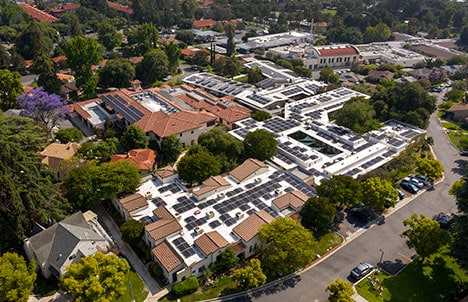Pilgrim Place goes green by making investment in the sun

Pilgrim Place recently installed 2,269 photovoltaic solar panels on five campus buildings and a new carport structure.
With the help of Home Performance Matters and Above All Construction, the retirement community moves one step closer to achieving goals set in its sustainability plan.
In 2013 the executive committee of the board for Pilgrim Place unanimously approved a sustainability plan proposed by the campus Environmental Concerns Committee (ECC). The resulting goals were reached through small group discussions involving about half the Pilgrim Place residents.
Each solar panel weighs about 40 pounds, and will generate more than a million kilowatt/hours annually, according to a news release from Pilgrim Place.
“The previous consumption in all our public buildings on campus was about two million kW/hours yearly,” Jennifer Tomes, director of marketing and communications, explained. “We expect approximately a 40 percent reduction in those costs.”
The power generated by the new panels will be inverted and used right away or will serve as a credit against off-campus electricity used by another campus common building. The clean air and climate change impact for Pilgrim Place is substantial, Ms. Tomes said.
“For example, the 432 panels on three of our common buildings decrease the amount of carbon dioxide by 66,000 pounds per year. That is akin to planting 1,660 trees,” she said. “Pilgrim Place is committed to reducing our carbon foot print now and in the future.”
The savings will completely pay off the investment in less than nine years.
According to its website, Pilgrim Place’s Environmental Concerns Committee has been incorporated into the governance of Pilgrim Place, and an Energy Retrofit Group made up by residents and staff are busy educating residents and staff, as well as managing the process toward energy-efficiency solutions.
“Pilgrim Place has committed itself to become a comprehensive model for communities willing to plan and implement proven energy retrofit and production solutions,” the board shared on its website.
Specific sustainability goals for Pilgrim Place include retrofitting every house, apartment and common-use building on the campus for the best energy efficiency possible; to establish measurable and predictable levels of energy required for all the campus’s energy needs; to serve as a “living, workable demonstration site” to other communities in the state; and to, finally, install rooftop solar panels as a sustainable and regenerative resource for the remaining energy needs of the future.
Pilgrim Place had previously reduced water use by 50 percent over a four-year period and constructed three LEED-certified buildings on campus.
—Kathryn Dunn
editor@claremont-courier.com










0 Comments